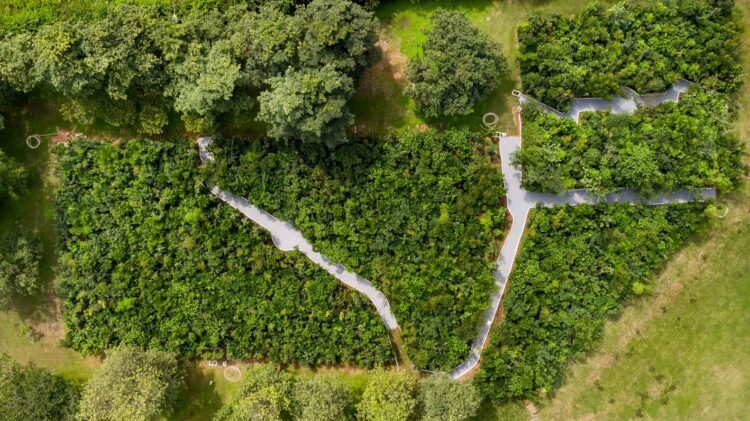Deforestation is the removal of forests and woodlands, typically to clear land for commercial, industrial, or agricultural activities. It has been identified as one of the leading contributors to climate change, causing extensive damage to the environment and biodiversity, leading to soil erosion, water pollution, and air pollution. Deforestation is also responsible for releasing greenhouse gases, particularly carbon dioxide, into the atmosphere.
Deforestation Report
A new study has revealed the countries contributing the most to global deforestation rates – and India has ranked in 2nd place after destroying an average of 668,400 hectares of forestry between 2015-2020. The team at Utility Bidder have created the Deforestation Report by looking at the countries with the highest deforestation rates, the most significant increase in deforestation, the greatest decrease in deforestation and the agricultural products most responsible for deforestation.
The reasons for deforestation have been discussed in this report. Therefore, we have elaborated on these reasons in detail in this article. Here we will explore the top reasons for deforestation, its consequences, and potential solutions.
Reasons for Deforestation
Agricultural Expansion
Agriculture is one of the primary reasons for deforestation. As the global population continues to grow, there is an increasing demand for food production. This demand has resulted in the conversion of forests into agricultural lands, particularly in developing countries. For example, in Brazil, the Amazon rainforest has been cleared for soybean and cattle farming.
Unsustainable Agricultural Practices
Agricultural practices such as clearing forests for farming, planting crops and raising livestock have been identified as a major driver of deforestation. As the global population continues to grow, the demand for food has increased, and more land is needed for farming. The cultivation of cash crops such as soybean, palm oil, and cocoa has also been linked to deforestation.
The production of beef and other animal products such as dairy is also a major driver of deforestation. To create grazing land, forests are often cleared, and this has been particularly prevalent in countries such as Brazil, where the Amazon rainforest has been destroyed to make way for cattle ranches. Unsustainable agricultural practices are also responsible for soil degradation, water pollution, and the loss of biodiversity.
Logging
The timber industry is another significant contributor to deforestation, particularly in tropical rainforests, which have a high diversity of tree species. Logging is often conducted illegally, and the wood is sold on the black market, leading to a lack of sustainable forest management.
Illegal Logging
Illegal logging is a major contributor to deforestation globally. Logging companies often operate illegally, cutting down trees in protected areas and national parks, and this has a devastating impact on the environment. Illegal logging is often driven by the demand for timber, which is used for construction, furniture, and paper production.
The illegal timber trade is also linked to corruption, money laundering, and organized crime. Governments in many countries have implemented measures to combat illegal logging, such as stricter regulations and the establishment of forest management systems. However, the problem persists, and illegal logging remains a major threat to the world’s forests.
Infrastructure Development
Infrastructure development, such as road construction, dams, and mining, has led to extensive deforestation, particularly in developing countries. These activities result in habitat fragmentation, loss of biodiversity, and soil erosion.
Fuelwood and Charcoal Production
Many people living in developing countries rely on wood as their primary source of fuel. This reliance on wood fuel has led to deforestation and has a detrimental impact on the environment.
Climate Change
Climate change is also a factor that contributes to deforestation. Changes in temperature and rainfall patterns can affect the growth and distribution of forests, leading to deforestation.
Consequences of Deforestation
Loss of Biodiversity
Forests are home to a diverse range of species, many of which are endangered. Deforestation has led to the loss of habitat for these species, resulting in their decline and, in some cases, extinction.
Soil Erosion
Forests protect soil from erosion by acting as a natural barrier. When forests are cleared, the soil is exposed to the elements, leading to soil erosion.
Water Pollution
Deforestation can also lead to water pollution. When forests are cleared, sediment, pesticides, and fertilizers can wash into rivers, polluting water sources.
Greenhouse Gas Emissions
Deforestation is a significant contributor to greenhouse gas emissions, particularly carbon dioxide. When forests are cleared, the carbon stored in the trees is released into the atmosphere, contributing to climate change.
Climate Change
Deforestation contributes to climate change by reducing the amount of carbon that forests can absorb. Forests absorb carbon through photosynthesis, but when they are cleared, this carbon absorption is lost.
Solutions to Deforestation
Sustainable Forest Management
Sustainable forest management involves balancing the economic, environmental, and social aspects of forestry. This approach ensures that forests are managed in a way that is environmentally sustainable, socially beneficial, and economically viable.
Reforestation
Reforestation involves planting trees to replace those that have been cut down. Reforestation is an effective way to combat deforestation and has the added benefit of restoring habitat for wildlife.
Reduced Consumption of Wood and Paper Products
Reducing the consumption of wood and paper products is an effective way to combat deforestation. This can be achieved by recycling paper products, using electronic communications instead of paper, and using sustainable wood products.
Alternative Agricultural Practices
Alternative agricultural practices, such as agroforestry and sustainable agriculture, can reduce the need for deforestation. These practices involve growing crops and trees together.
Conclusion
Deforestation is a major threat to the environment, contributing to climate change, loss of biodiversity, and soil degradation. The causes of deforestation are complex and multifaceted, with factors such as agriculture, urbanization, infrastructure development, and climate change all playing a role. However, there are steps that can be taken to combat deforestation, such as sustainable forest management, reforestation, and the promotion of sustainable agricultural practices.
Governments, businesses, and individuals all have a role to play in reducing deforestation, and it is essential that we take action to protect the world’s forests. By working together, we can create a more sustainable future for ourselves and for future generations.
(India CSR)






















